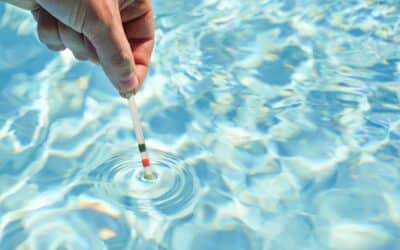How Can I Prepare My Pool for the Winter?
Below, we dive into the key steps for prepping your pool for Canadian winters.
Our step by step process will outline the following:
- Organize and inspect the equipment
- Prepare the pool
- Disconnect pump and filters
- Turn off and drain pool heater
- Drain water lines
- Balance chemicals
- Place pool cover on
- Clean equipment and safely store it
Organize and Inspect Equipment
Before you begin the closing process, gather all of the equipment that you’ll need. This includes winter chemicals, an air compressor or Shop-vac, winter cover, skimmer plugs, water bags, and return jet plugs. This is also a good time to inspect the pool cover to ensure it’s in good condition and doesn’t have any damage or tears.
Prep the Pool for Closing
Next, get your pool and surrounding areas ready for closing by removing any toys, ropes, diving boards, and other accessories. Also, don’t forget to switch off any water features. Once the pool and vicinity are clear, it’s time to start cleaning the pool. You can do this with a vacuum system to remove any lingering dirt and debris in the pool. When it’s cleaned, complete this step by draining the pool, so the water line is slightly below the return line.
Disconnect Pump and Filters
Start by pulling out the drain plug to disconnect the pump and drain any water from it. You’ll need to briefly turn off the pump to ensure there is no water in it and then turn it back on right after. If you have a sand or cartridge filter, follow the designated instructions for draining it. To clean it, keep the backwash valve open and use a Shop-Vac to clean out the valves. Remove the jet fittings and store all of these away somewhere that’s sealed and safe from the winter weather.
Protect Skimmer Hole
To protect the skimmer hole during the winter, it’ll need to be plugged. You can do this by using a skimmer plate if your pool has a vinyl lining or a Gizmo. Just make sure it has a tight fit.
Balance Water Chemistry
Whether you have a standard chlorine pool or a saltwater pool, balancing the chemicals before closing it up is crucial. This will prevent algae from developing and staining the pool in the spring. You can source the chemicals individually or use a pool closing kit that will have everything in one unit to make it easier. Just be sure to follow the instructions very carefully. These will typically include shock, stain, scale remover, and algaecide.
Put the Pool Cover On
Finally, put on the winter pool cover to protect it from any debris over the next several months. Once you lay it across, it will need added weight to keep it in place during those high winds. Use water bags for this and place them all along the edge of the cover – but don’t overfill them. If you have a specialized safety cover, you won’t need water bags. Use the anchors instead.
Clean and Store Equipment
All that’s left is cleaning any accessories and equipment and placing them away from someone safe and dry from the weather until next year.
The pool closing process is vital for preserving the condition of your pool and getting the most out of your investment. If you’d prefer to hand over the work to a professional instead, give us a call at Benson Pools, and we’ll take care of all the work for you. Contact us today to learn more about our services or to book your pool closing.


